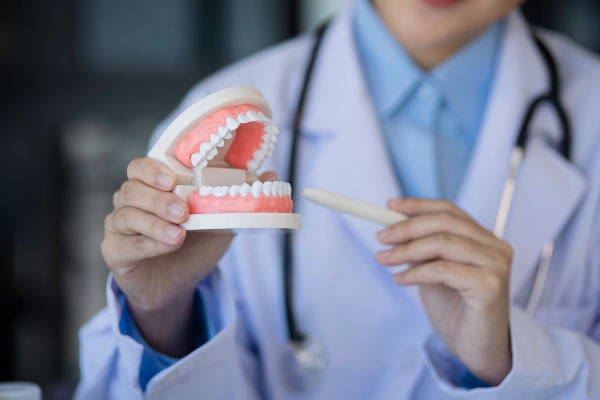Important Facts To Know About Dental Crowns

When dentists recommend dental crowns, they are referring to caps that they place atop damaged teeth. Crowns restore the shape of a patient's tooth, covering the tooth and protecting it from further damage when fillings are insufficient. Dentists shape crowns from porcelain, resin, metal, or ceramic.
5 facts about dental crowns
Every day, dentists use dental crowns to restore smiles. When dentists suggest crowns, patients may not understand the ins and outs of the treatment. Having facts helps patients feel more informed about the procedure.
Crowns perform like natural teeth
Patients may fear crowns will not feel like regular teeth. In reality, patients cannot usually distinguish between crowns and regular teeth. Dental crowns fit over natural teeth and may appear no different than a patient's regular teeth. Additionally, a patient can eat and speak like normal without using any other device.
Crowns prevent jawbone recession
A tooth extraction not only affects a patient's smile and confidence, but it can affect the jawbone and facial structure. The jawbone relies on the teeth for stimulation. Without stimulation, the jawbone begins to atrophy. In the case of decay or an abscess, a dentist can treat the tooth and protect it with a crown. The dental crown prevents recession.
Crowns can last up to 30 years
When patients care for their crowns, the crowns can last for decades. On average, a crown may last for about 10 to 15 years, but some may last for up to 30. Caring for dental crowns involves treating bruxism and avoiding actions that may break or damage the crown. Additionally, regular brushing and flossing protect crowns. Patients should practice care not to abuse their teeth. Chewing ice cubes and biting open bottles or pencil tops can harm the teeth and cause damage to crowns. While difficult to damage, porcelain caps can crack or break when treated roughly.
Crowns treat damaged teeth
One of the primary reasons patients seek crowns is to save the teeth. Dentists use crowns to treat cracked, broken, and infected teeth. Infection requires a root canal. The patient's tooth becomes more vulnerable to breakage and further infection following the root canal. To protect the tooth, dentists install a cap. The only other option for a crown is tooth extraction in many cases.
Crowns support bridgework
Patients missing multiple teeth can still benefit from bridgework. A bridge is a device that fills the gap with pontics or artificial teeth. The dentist has to connect the bridgework to natural teeth to put the teeth in place. Dentists use dental crowns to anchor the bridgework properly. Crowns can also top implants — the implants are anchored in the jawbone for extra stability.
Understanding the dental crown procedure
To begin, the dentist takes steps to numb the area to ensure a patient's comfort. Next, they remove all diseased and decayed tissue. Once this is complete, the tooth is ground down and reshaped to resemble a cube or cylinder. This allows for an even surface that the crown can properly adhere to.
Scans or impressions are taken so the crown can be milled to the appropriate size and shape. The dentist will also match the color to the patient's natural teeth for a seamless look. The dentist places a temporary crown over the treated tooth until the final crown is ready, a process that typically takes two weeks to complete at an off-site lab. The patient returns to the office to have the temporary crown removed, and the permanent one is cemented in place. In some situations, an office may offer same-day crowns, where the permanent covering is milled in the office and no temporary option is needed.
For a tooth to be treatable by a crown, the root must be healthy and intact and there must be enough viable tooth tissue above the gum line to support the new cover. If this does not apply to a patient's situation, other treatments may be recommended. If the root cannot be repaired or the damage left little to no tooth material on the surface, the tooth will need to be extracted and replaced with a bridge, an implant, or a denture.
Conclusion
Dental crowns may be a worthwhile option for patients who require restorative dentistry. Crowns can restore a smile, function as regular teeth, and last for over a decade. Before a patient agrees to dental crowns, it may help the patient to learn as much as possible about the procedure to ensure an expected outcome.
Request an appointment here: https://drjosephmurray.com or call J.D. Murray DDS & Associates at (404) 410-2526 for an appointment in our East Point office.
Check out what others are saying about our dental services on Yelp: Dental Crowns and Dental Bridges in East Point, GA.
Recent Posts
A dental crown restoration involves two dental visits. Dentists use this type of restoration to repair a range of tooth damage types, including decay, chips, cracks, and teeth worn down by continuous grinding. This guide discusses what you can expect during a dental crown restoration and how a dentist can help ensure a safe and…
Anyone who has had dental crowns understands how beneficial they can be. Crowns are highly durable and work to improve the look of teeth, restoring a person's smile. A crown is often used to prevent a damaged tooth from deteriorating further. Others may need a crown to complete a bridge or implant treatment. A dental…
It is possible to use dental crowns to restore teeth that have become damaged beyond repair, whether due to decay or trauma. A dentist may recommend this common type of treatment for a tooth that is: Seriously chipped Severely cracked or broken Weakened from numerous cavities or fillingsWhile the tooth can have extensive damage, it…
Looking for a general dentist? General dentistry is one of the more popular dental niches operating today, as general dentists perform the necessary general dental services that patients need on a regular basis. This type of dental professional is one who can be compared to a general practitioner, as they are a patient's first contact…


